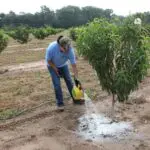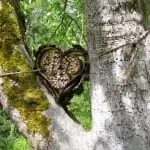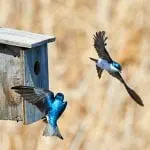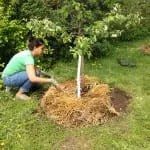Learn how beneficial nematodes can help you protect your fruit trees from plum curculio and other pests.
A tell-tale sign of tree stress: Causes of gummosis on your cherry tree

"What's wrong with my cherry tree?"
That's what a neighbour asked me recently. A huge amount of amber coloured, jelly-like goop was oozing out of the trunk and branches of his cherry tree as you can see in the image above.
That sticky goop is called gummosis and it's a sign that a tree is under stress. But what causes gummosis? And how can you prevent and treat it? We'll explore that in this article.

There are many possible causes of gummosis in cherry trees
So, what are the causes of gummosis in cherry trees? There are a number of possibilities:
- A string trimmer or mechanical injury can cause gummosis.
- Gummosis can be the result of a broken, torn or incorrectly pruned branch.
- Gummosis can form in a sun scald wound on the trunk of the tree.
- Or it can be triggered by an insect like peach tree borers.
- But often the cause of gummosis is a fungal or bacterial infection. And how do those infections get into the tree? Well, they are opportunists! And these pathogens infiltrate when there is a wound in the tree resulting from one of the situations above!

Let's see how tree wounds develop.
- The tree is wounded by a string trimmer, a bad pruning cut, or a pest that breaks through its protective bark.
- A canker, or sunken patch, forms on the branch, bark or trunk of the tree. That canker may be a darker colour than the trunk and it may harden and form a corky edge.
- The branch may swell, and the tree starts exuding sticky sap.
It may be easy to overlook a fungal or bacterial canker in the early stages, but when the tree's sap starts leaking out, these cankers are hard to miss. Think of the gummosis as your fruit tree's call for help. As the grower you need to resolve this problem...before it is too late!
Bacterial canker as a common cause of gummosis in cherry trees
While there are many things that can trigger a wound in your cherry tree, the factor that makes things worse is a bacterial disease called Pseudomonas syringae which is also known as bacterial canker. This pathogen affects other stone fruit trees as well like plums, apricots and peaches.
Other symptoms of bacterial canker include brown spots or holes on the leaves and the death of new shoots and young branches.
Fruit Trees
That Thrive

How to treat gummosis in cherry trees
The best way to treat gummosis or bacterial canker in cherry trees is to remove it early on. When you remove it, you will remove the bacterial pathogen.
To remove bacterial canker on your cherry tree, prune off the diseased branch. Be sure to cut at least two inches (5 cm) before the canker appears on the branch as the pathogen may also be hidden inside the branch.
Once you remove the diseased wood, dispose of it in a sealed bag. Do not not put it in the compost, where bacterial canker can continue to spread.
After pruning out the diseased branches, disinfect your pruning tool with isopropyl alcohol and wipe it with a clean rag. This reduces the risk of spreading the pathogen to other trees.
If you let things go too far, the bacterial canker and gummosis will take over the tree. When there is gummosis all over the tree, in its trunk, branches and even roots, you will have to cut the tree down to stop the problem from spreading to other trees nearby.
And if you're planning to plant another tree, don't use the same location as the pathogen may remain in the soil.

How to treat gummosis in the tree's trunk
Are you seeing early signs of gummosis on your cherry tree? There are times when you can save a mature tree that has a small patch of bacterial canker in its trunk. Here's how:
- Spread some sheets of newspaper out around the tree to gather all the infected tissue. You do not want to leave any of the pathogen in the soil as it can continue to spread.
- Using a boxcutter with a new blade or a carpet knife (affiliate link), cut a circle around the wound and scrape out the infected tissue inside the circle. Keep scraping until you expose the heartwood of the tree.
- Put the newspaper and infected tissue in a bag and throw it away so that the pathogen can't continue to spread.
- Spray the wound with a horticultural copper spray or Bordo to prevent reinfection.
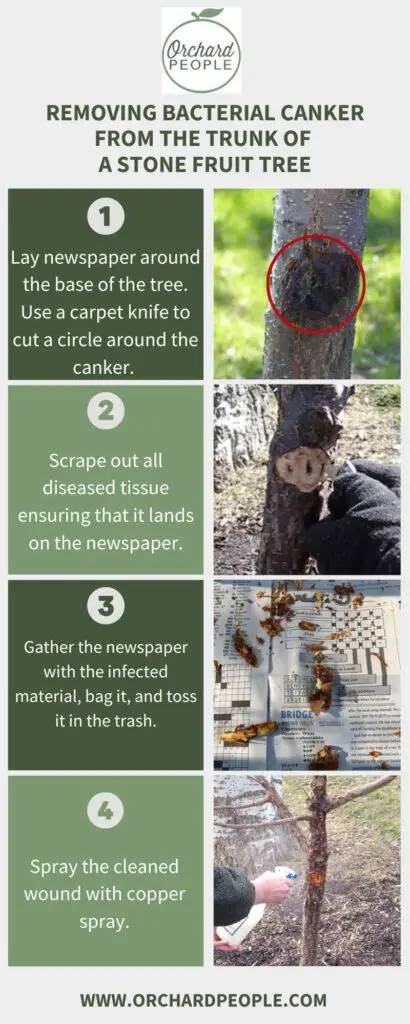
In Ben Nobleman Park Community Orchard, we successfully treated an apricot tree in this way and our tree has recovered and is thriving today.
And the moral of the story for organic fruit tree growers? It's important to learn to recognize fruit tree diseases early on, so that you can nip them in the bud. If you want to learn how to do that and how to keep your fruit trees healthy and productive, check out our award-winning online courses at OrchardPeople.com.
latest posts on orchardpeople.com
- Companion Planting Fruit Trees: A Beginner’s Guide to Permaculture Guilds
- Grow Fruit Trees Fast - Your Free Video Mini-Course
- How to Choose the Right Fruit Trees: A Beginner's Guide
- The Medlar Fruit Tree: Easy to Grow, Productive and Shaped like a Dog's Bottom?
- When to prune fruit trees

Susan Poizner
Learn more about Susan on the about us page.
